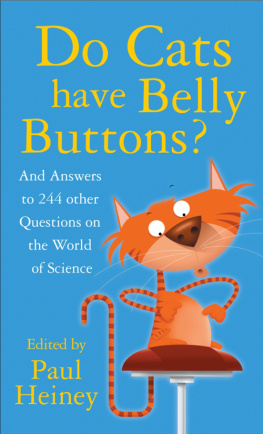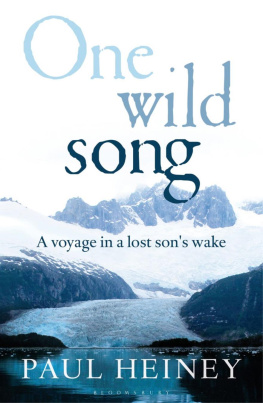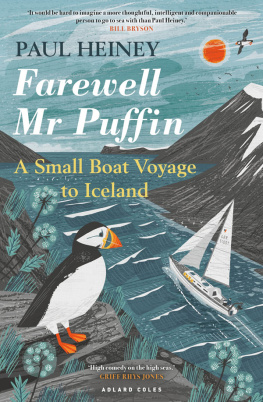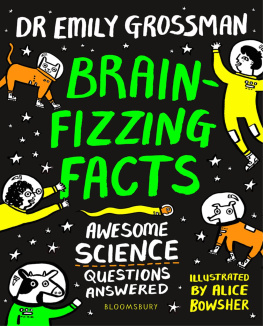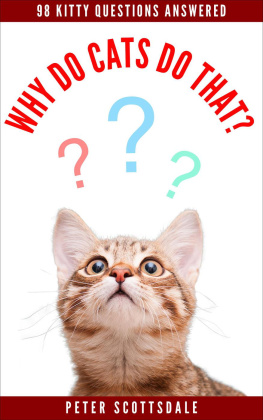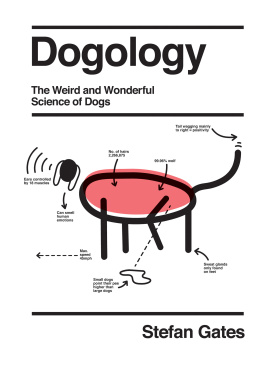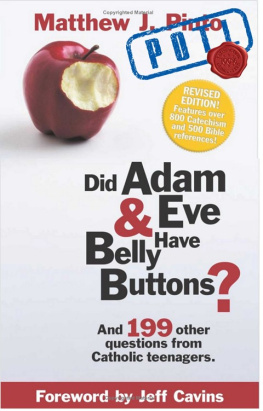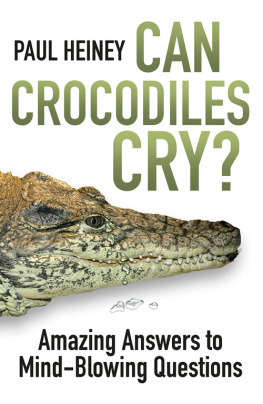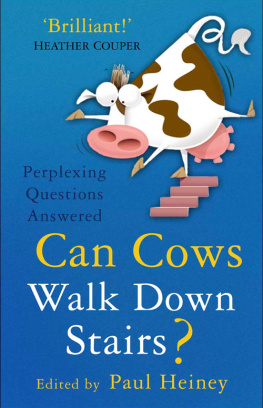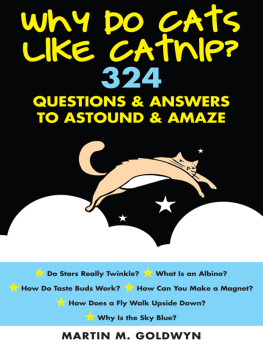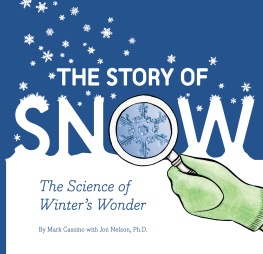
Contents
Big Ears to Big Sneezes
Funny Bones to Laughing Gas
Belly Buttons to Hairy Eskimos
Happy and Sad
Sweet Dreams
Why the Difference?
Just Wondering
Sleepy Bears to Smiling Crocs
Mighty Ants to Half-Dead Worms
Purring Cats to Belly Buttons
Bats to Exploding Seagulls
Fizzing Bubbles to Falling Bubbles
Rising Heat to Maple Syrup
Wet Windows to Bending Rainbows
AC to DC
Tangled Bedding to Tasty Toast
Spinning Planets to Atomic Bombs
Lightning Bolts to Balloons
Thirsty Oaks to Massive Mushrooms
Twinkling Stars to the Man in the Moon
Crashing Comets to Junk in Space
Yo-yos to Frisbees
Clouds to Vapour Trails
And All the Other Things I Dont Understand
Lumps of Light to Absolute Zero
Lets leave belly buttons out of it for the moment and remember another old proverb about cats which says curiosity killed the cat. That one has always bothered me. What could ever be risky about being curious? Surely there cant be anything more exciting than forming a question in your mind, turning it over till youve looked at it from every angle, deciding you dont know the answer and then, armed only with your curiosity, go seeking the answer? Theres nothing foolhardy in being curious. Surely one of lifes most rewarding journeys are the steps we take from question to answer?
But since this is a book of science questions and answers lets be scientific about this and ask ourselves if there is any evidence that having a curious mind does you harm? As a sample of the population, let us take the tens of thousands of people who, a few years ago, phoned or emailed an organisation called Science Line.
Science Line was set up with a simple purpose: it was there to answer all manner of queries from deadly serious to wildly zany, on every branch of science from cosmic physics to microbiology. It fell to a gang of enthused, young scientists to try and answer them. If they couldnt find the answer they found someone who could, and in that way the most humble enquiry often found its way onto the desks of some of the top scientific brains, who were delighted to help. Suddenly science didnt just belong to the people who knew all the answers, it could be shared equally with those who posed the questions.
And was anyone harmed by asking questions of Science Line? I dont think so. I have no proper scientific proof, but I doubt if any of the 500 people who emailed every week (adding up to tens of thousands over the years) came to any harm. So we can reasonably assume, if not scientifically prove, that no amount of curiosity ever killed any questioner, even a cat.
But, of course, what the proverb is really suggesting is that if you are too interested in things which are none of your business, you could be in danger. I can see some sense in that in certain circumstances. But there is nothing to be found anywhere in science into which we have no right to stick our noses. Science is everyones business it describes our lives, our world, our universe and Science Line made it that bit easier for everyone to share and understand it.
Although some questioners sought deep insight into the mysterious depths of quantum theory or molecular movements, others were happy simply to ask why squirrels have bushy tails, or even if cats have belly buttons? Indeed, the puzzled soul who asked whether cows can walk downstairs, kindly provided us with the title of the first book in this series.
For this second book, I have revisited the vast database of questions and answers that survived after Science Line finally closed for business, when the funding ran out. There seems to be no end to it. It sometimes feels as if I have not only struck gold, but the deeper I dig the more gold there is. If you thought Can Cows Walk Downstairs? covered pretty much everything you needed to know, in this book you will find areas of science we have not visited before, such as the science of bubbles or the movement of ping-pong balls, a journey to the centre of the Earth or making toast in a thunderstorm.
Once again, I must thank those who asked the questions, and those who answered them. They were: Sian Aggett (Biology), Alison Begley (Astronomy and Physics), Duncan Kopp (author of Night Patrol ), Khadija Ibrahim (Genetics), Kat Nilsson (Biology), Jamie McNish (Chemistry), Alice Taylor-Gee (Chemistry), and Caithlin Watson as well as the numerous distinguished experts whose knowledge they drew upon when their own was stretched to its limits.
And finally, may I reassure you that no cats were harmed in the preparation of this book. And to discover the truth about their belly buttons, read on.
Paul Heiney
2007
Big Ears to Big Sneezes
Funny Bones to Laughing Gas
Belly Buttons to Hairy Eskimos
Happy and Sad
Sweet Dreams
Why the Difference?
Just Wondering
BIG EARS TO BIG SNEEZES
Do people with sticky-out ears have better balance?
Its true that our ears allow us to keep our balance, but I think you have got hold of the wrong end of the stick about how they actually achieve that. It is nothing to do with the size of the external ear, the pinna.
A special part of the inner ear, called the vestibular apparatus, helps the body to cope with changes in position. This structure contains hair-like cells which wave about in the fluid inside the inner ear and connect to lots of tiny nerves. These all work together to tell the brain what position the body is in and whether it is moving or not. When the information from these hairs is at odds with messages going to the brain from our eyes, we can suffer from motion sickness such as car or sea-sickness.
However, these messages originate in the inner ear, not the outer ear, and so the size of your external ears make no difference to your balance at all. Unless, of course, theyre so large that you trip over them.
Can sound hurt your ears?
Parents are always nagging their children to turn it down! and not just because it is annoying. Sound can most certainly damage your ears. Hearing tests on gunners and people who have worked near jet engines show they can no longer hear high-frequency sounds, and have difficulty hearing normal speech. Even wearing headphones with the sound turned right up for long periods of time can cause some damage to hearing.
Sound travels in waves through the air but, unlike waves on water which we can see coming towards us and duck away from if we have to, there is no simple way to see a damaging sound wave coming at you. The only way to measure the power of a sound wave is to use a microphone to convert the sound waves into electrical waves, and measure the voltage produced by the microphone. The usual scale measures the loudness (sound pressure level) in decibels (dB), on a special sort of scale where 40 decibels is ten times louder than 20 decibels and 60 decibels is a hundred times louder than 20 decibels.
0dB, which is reckoned as being the threshold of hearing, represents the quietest sound we could ever hear the sound of an empty building on a quiet night in the country. You would probably play music at about 40dB to keep you company while you do your homework. Traffic noise at rush hour in a busy city might reach 80dB, and the threshold of pain would be 120dB roughly what youd hear if you stood at the end of the runway when a jet aircraft took off.
Hearing loss occurs when there is severe damage to the structure of the highly sensitive inner ear, particularly the hair cells which transmit vibration to the brain for recognition. The first effects will be the loss of high frequencies which are important as they enable us to recognise the difference between similar words, such as thrill and sill. In severe cases, conversation begins to sound like a continuous mumble.
Next page
